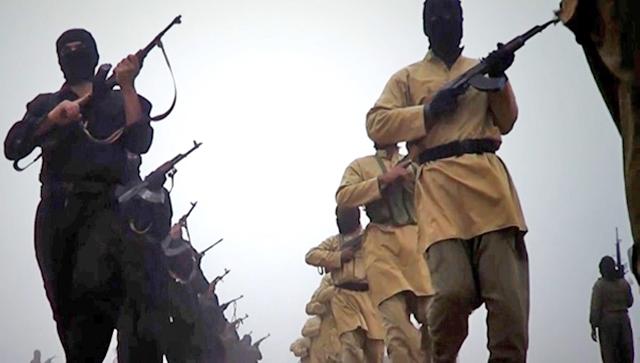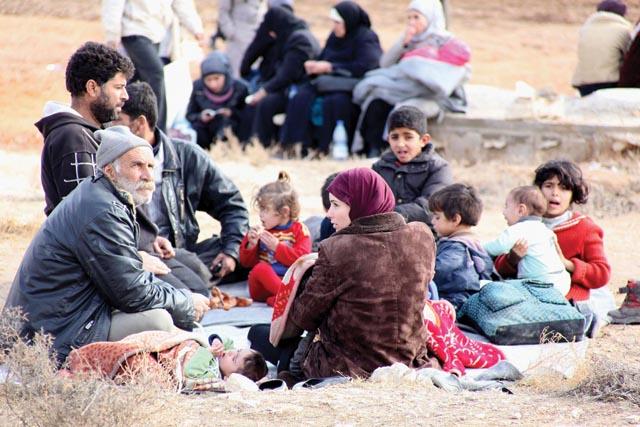You are here
Al Qaeda hijacks spirit of Syria revolt three years on
By Reuters - Mar 11,2014 - Last updated at Mar 11,2014

KILLIS, ON THE TURKISH-SYRIAN BORDER — Syrian refugees in this border outpost were delighted to hear their home town of Azaz had been liberated — not from Bashar Assad’s troops but from Al Qaeda fighters who subjected them to a regime that included torture and public beheadings.
For Syrians who three years ago rose up against 43 years of Assad family rule, living under the hardline Sunni jihadists who said they had come to save them from the president’s atrocities was even worse than Assad himself.
While neither Assad nor the rebels have the upper hand, there is a growing sense among his foreign opponents that the battle for Syria has become a twin-track operation, with defeating the jihadists as important as ousting Assad.
In interviews with Reuters, Syrians who have escaped areas that have fallen under the control of Al Qaeda-linked groups have spoken of the way the jihadists have imposed their harsh and often violent version of Islam on their fellow Muslims.
When the uprising started in March 2011 — part of the wave of Arab Spring revolts — many Syrians had hoped either for reform or a quick end for Assad.
Three years on, Assad is still in power, while his subjects have been gassed, starved, exiled and bombed with impunity.
Many of those who initially succeeded in liberating large parts of northern Syria from government control soon found themselves under the yoke of foreign jihadists.
Syria’s conflict has drawn in foreign fighters who, while ostensibly rallying to the cause of their Muslim brothers against Assad, have turned their guns on rival rebel groups.
They accuse them of apostasy for not following their austere version of Islam, which rebel veterans insisted was alien to Syria’s traditions.
The priority of Al Qaeda inspired Islamic State of Iraq and the Levant (ISIL), as one of its fighters told Reuters, is to set up an Islamic Caliphate in the Middle East and on the doorstep of Europe, rather than fight the Assads.
Tangled situation
The situation in north and eastern Syria is chaotic, with scores of front lines where rebel fighters face either government forces or jihadist extremists.
The internationally recognised Syrian opposition in exile has lost credibility with fighters on the ground, who dismiss them as five-star hotel revolutionaries, squabbling at inconsequential meetings from Istanbul to Geneva.
At the same time, there has been a pushback against ISIL — which has withdrawn to its strongholds bordering Iraq — not only from moderate and mainstream Islamist rebels but from rival Al Qaeda forces such as the Nusra Front, which is more Syrian in its make-up and its focus on fighting the government.
To further complicate matters, Iran, the main Shiite power, and Saudi Arabia, its Sunni rival wedded to the Wahhabi puritanism that inspires jihadis, see Syria as the front line in their Shiite-Sunni war for supremacy in the Arab world.
Syrians, according to the UN, are about to replace Afghans as the world’s largest refugee population. So far 2.4 million have fled a conflict that has killed 140,000 people.
“We’re following in the footsteps of Bosnia,” said Sarkis Naoum, a Lebanese columnist and expert on Syria. “This war will take its time, it might last 7, 8 or 10 years until world powers decide to resolve it.”
A Gulf official said world powers now realised that inaction had been a mistake, increasing the numbers of potential terrorists who are a threat to the region and beyond.
There were now two objectives in Syria — to defeat these “terrorists” and “accelerate the exit of Assad”, he said.
Foreign jihadists
While hard information is scarce, one expert estimates Al Qaeda has 25,000 fighters in Syria. Foreigners number 10,000, of which 2,000 are from Europe.
Inside Syria, residents speak of lawlessness and terror, a state of chaos and implosion of state authority.
Assad controls most territory from Damascus to the Mediterranean coast, home to his Alawite sect, an offshoot of Shiite Islam and other minorities.
To the north, moderate Sunni rebels are in control near the border with Turkey while ISIL has tightened its grip along the Euphrates towards Iraq, linking up with Al Qaeda in Iraq.
In Syria’s northeast, Kurds have established a form of self-government similar to the Iraqi Kurds in northern Iraq.
In the south, Sunni rebels have seized areas from Deraa, near Jordan, to Quneitra in the foothills of the Golan Heights.
While that oversimplifies the fragmentation of Syria, in which power changes from neighbourhood to neighbourhood, street to street, checkpoint to checkpoint, the overriding reality is that neither Assad nor the rebels have the upper hand.
Blighted lives
The influx of jihadis appeared to signal a shift against Assad, but in reality it has blighted the lives of Syrians in rebel areas and besmirched their cause, by associating it with terror. The testimony of those who lived it is harrowing.
Abdallah Khalil, a 25-year-old activist and student of Sharia law, recalls the joy of liberating Azaz in 2011.
“Life was OK but then these jihadis started arriving. They set up a military training camp, run by a jihadi from Egypt known as Abu Obeida Al Muhajer. First he told us it is banned to clap or sing in protests, then they killed the mentor of the revolution, Sheikh Youssef, a moderate Muslim.
“They told us: ‘You are infidels who want to sin, you don’t want to apply Sharia’,” said Khalil. “Islam is strongly present in Syria but not this kind of Islam. They disfigured the religion and the revolution.”
Activists described a feud inside Al Qaeda whereby ISIL, led by Iraqi veteran Abu Bakr Al Baghdadi, tried to take over Nusra, led by Abu Mohammed Al Golani, but was rebuffed by Ayman Zawahiri, successor to Osama Bin Laden as the head of Al Qaeda.
The Syrian fighters stayed with Golani and the Nusra Front, they said, but Azaz ended up under ISIL, known colloquially as Daesh. That was when local people learned what the black flags of the Caliphate Jihadis meant.
“They went into a pre-school to segregate the boys from the girls,” said Mahmoud Osman, 27, an activist from Aleppo.
“They started going to schools to check whether the girls were wearing the head-to-toe black chador and they started asking girls to marry them. Parents stopped sending their daughters to school,” he said.
Assad not a priority
Al Qaeda banned smoking, music and any mingling between men and women unless they were closely related. They forced Christians to pay protection taxes, activists said. They beheaded men in public squares because they fought for the mainstream rebel Free Syrian Army (FSA).
“We used to hear about them or see them in movies but now we see them for real,” Osman added.
After local Islamic scholars pronounced it legitimate to fight Daesh, Azaz residents say, ISIL pulled back to its stronghold of Raqqa in the east.
While Daesh held territory, the government left the towns unmolested, activists said. Only when they left did government forces drop barrel bombs — proof, they say, that Assad wants the most hardline Islamists to prevail in rebel areas so he can portray his fight as a battle with Al Qaeda.
Assad has repeatedly referred to his enemies as terrorists.
Khaled Ibrahim, 30, who worked in advertising before the war and is from Raqqa, describes his home as an ISIL province, ruled by terror. He said every Friday they executed activists, Free Syrian Army fighters and also looters in the public square, either by the sword or by gunfire.
He and others said that anybody who worked for a foreign NGO or a media outlet was considered an “infidel agent”.
Abu Thaer, a 25-year-old computer science student and media activist, who was held by ISIL with FSA fighters and NGO workers, said “every day that passed there I wished for death”.
“They used to come into our cell with the sword, they would tell us ‘you are infidels, we will cut your throat’. They started torturing the FSA fighters: One day they would cut a finger, another day a slice of their ear and let them bleed.”
Abu Alaa, 25, is a defector from ISIL now living in Killis.
Formerly in the FSA, he fought for six months with the veteran jihadi who uses the nom de guerre Abu Omar Al Shishani (the Chechen), the Daesh commander who captured a government air base near Aleppo last summer.
Abu Alaa was jailed and then escaped after trying to help friends who were being rounded up, tortured and executed.
“They were torturing the prisoners with electricity and beatings,” says Abu Alaa. “They liquidated many on the grounds they are allies with the West.”
Abu Khaled, a former Syrian soldier and now an ISIL officer, made little effort to contradict these chilling accounts.
Reached by Skype in northern Syria, he spoke of a network of contacts abroad including in France and Britain, operating through mosques, but also using social media and the internet.
“We don’t have a problem getting fighters, and we have been able to get them into Syria. We are receiving jihadis from all over the world, from Chechnya, Iraq, Afghanistan, Saudi Arabia, Libya, Kuwait, Jordan, Egypt, Yemen, Turkey, Britain and France. ISIL has some 6,000 fighters,” he said.
ISIL ranks were swelled by 500 jihadis broken out of Abu Ghraib prison in Iraq, and a further 700 freed from Sednaya military jail near Damascus in what was seen in rebel and Western circles as an attempt by Assad to boost jihadi forces in Syria at the expense of mainstream rebels.
“The aim of the ISIL is to set up an Islamic Caliphate that will attract Muslims from all over the world. Our aim is to fight the infidels whether it is Bashar Assad or the Free Syrian Army,” he told Reuters.
“Any apostate should be beheaded and women must follow the Sharia,” he said.
Related Articles
Al Qaeda’s Syrian branch issued a loyalty pledge on Wednesday to the Islamic State of Iraq and the Levant (ISIL) at a tinderbox town on the Iraqi border, a monitor said.
A six-week offensive by the Islamic State of Iraq and the Levant (ISIL) against rival Islamists in eastern Syria has killed 600 fighters and driven 130,000 people from their homes, a monitoring group said on Tuesday.
Syrian rebels and activists have launched a second “revolution” nearly three years into the uprising against President Bashar Assad, this time against a powerful Al Qaeda affiliate accused of brutal abuses.
















